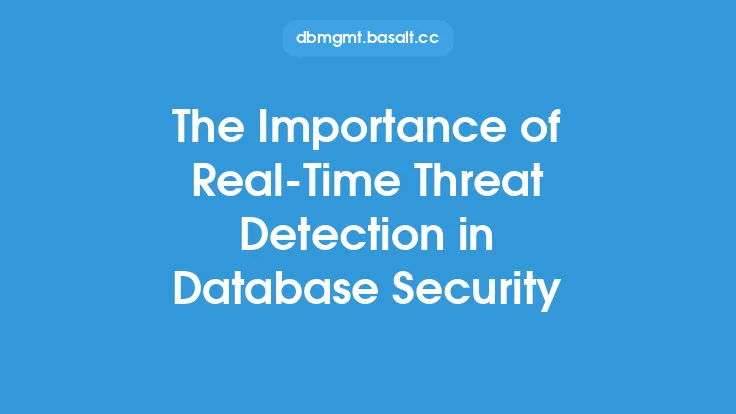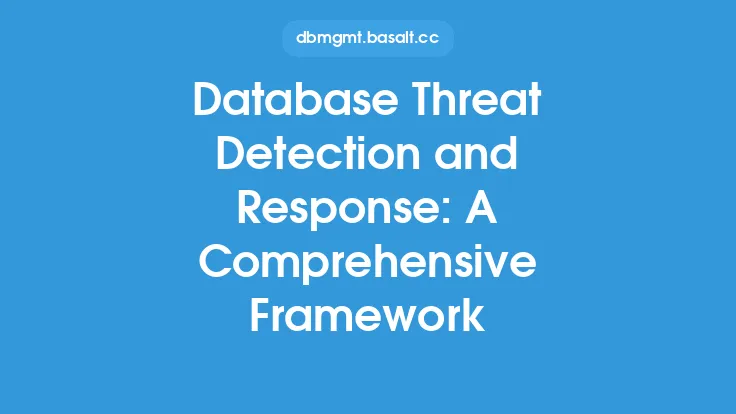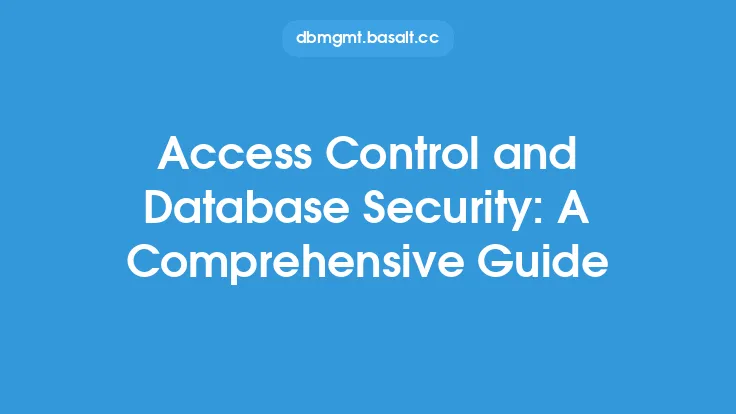The ever-evolving landscape of database security is a pressing concern for organizations worldwide. As databases continue to be a prime target for malicious actors, it's essential to stay ahead of emerging threats. Database threat intelligence is a critical component of a comprehensive database security strategy, providing organizations with the necessary insights to detect, respond to, and prevent threats. In this article, we'll delve into the world of database threat intelligence, exploring its importance, key concepts, and best practices for implementation.
Introduction to Database Threat Intelligence
Database threat intelligence refers to the process of collecting, analyzing, and disseminating information about potential or actual threats to an organization's databases. This information can come from various sources, including internal logs, network traffic, and external threat intelligence feeds. The primary goal of database threat intelligence is to provide organizations with a proactive approach to database security, enabling them to anticipate and mitigate threats before they materialize.
Key Concepts in Database Threat Intelligence
Several key concepts are essential to understanding database threat intelligence. These include:
- Threat indicators: These are signs or patterns that suggest a potential threat to the database. Examples of threat indicators include unusual login attempts, suspicious query patterns, or unexpected changes to database configurations.
- Threat intelligence feeds: These are external sources of threat information, such as commercial threat intelligence providers or open-source feeds. These feeds can provide organizations with valuable insights into emerging threats and tactics, techniques, and procedures (TTPs) used by malicious actors.
- Anomaly detection: This refers to the process of identifying patterns or behavior that deviate from expected norms. Anomaly detection is a critical component of database threat intelligence, as it enables organizations to detect potential threats that may not be caught by traditional security controls.
- Predictive analytics: This involves using statistical models and machine learning algorithms to predict the likelihood of a threat materializing. Predictive analytics can help organizations prioritize their security efforts and focus on the most critical threats.
Implementing Database Threat Intelligence
Implementing database threat intelligence requires a structured approach. The following steps can help organizations get started:
- Define the scope: Identify the databases and data assets that require protection. This will help organizations focus their threat intelligence efforts and prioritize their security resources.
- Collect and integrate data: Gather data from various sources, including internal logs, network traffic, and external threat intelligence feeds. This data should be integrated into a centralized platform to facilitate analysis and correlation.
- Analyze and correlate data: Use analytics and machine learning algorithms to identify patterns and anomalies in the data. This will help organizations detect potential threats and predict the likelihood of a threat materializing.
- Disseminate intelligence: Share threat intelligence with relevant stakeholders, including security teams, incident responders, and database administrators. This will ensure that everyone is aware of potential threats and can take proactive steps to mitigate them.
Best Practices for Database Threat Intelligence
Several best practices can help organizations optimize their database threat intelligence efforts. These include:
- Continuously monitor and update threat intelligence: Threat landscapes are constantly evolving, and organizations must stay up-to-date with the latest threats and TTPs.
- Use a combination of internal and external data sources: Internal data sources, such as logs and network traffic, can provide valuable insights into potential threats. External data sources, such as threat intelligence feeds, can provide context and help organizations stay ahead of emerging threats.
- Implement automated analytics and machine learning: Automated analytics and machine learning can help organizations detect patterns and anomalies in large datasets, reducing the risk of human error and improving the efficiency of threat detection.
- Integrate threat intelligence with incident response: Threat intelligence should be closely tied to incident response efforts. This ensures that organizations can quickly respond to and contain threats, minimizing the impact on the business.
Technical Considerations for Database Threat Intelligence
Several technical considerations are essential for implementing effective database threat intelligence. These include:
- Data ingestion and processing: Organizations must be able to ingest and process large volumes of data from various sources. This requires scalable and flexible data processing architectures.
- Data storage and management: Threat intelligence data must be stored and managed securely, with appropriate access controls and encryption.
- Analytics and machine learning: Organizations must have the necessary analytics and machine learning capabilities to detect patterns and anomalies in the data.
- Integration with security controls: Threat intelligence should be integrated with security controls, such as intrusion detection systems and firewalls, to provide a comprehensive security posture.
Conclusion
Database threat intelligence is a critical component of a comprehensive database security strategy. By providing organizations with the necessary insights to detect, respond to, and prevent threats, database threat intelligence can help minimize the risk of data breaches and cyber attacks. By understanding key concepts, implementing best practices, and considering technical requirements, organizations can stay ahead of emerging threats and protect their sensitive data assets. As the threat landscape continues to evolve, database threat intelligence will play an increasingly important role in ensuring the security and integrity of organizational data.





